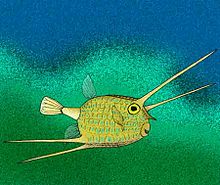| Ostraciidae Temporal range: | |
|---|---|
 | |
| Yellow boxfish Ostracion cubicus | |
| Scientific classification | |
| Domain: | Eukaryota |
| Kingdom: | Animalia |
| Phylum: | Chordata |
| Class: | Actinopterygii |
| Order: | Tetraodontiformes |
| Suborder: | Ostracioidea |
| Family: | Ostraciidae Rafinesque, 1810 |
| Genera | |
See text | |
Ostraciidae or Ostraciontidae is a family of squared, bony fish belonging to the order Tetraodontiformes, closely related to the pufferfishes and filefishes. Fish in the family are known variously as boxfishes, cofferfishes, cowfishes and trunkfishes. It contains about 23 extant species in 6 extant genera.






